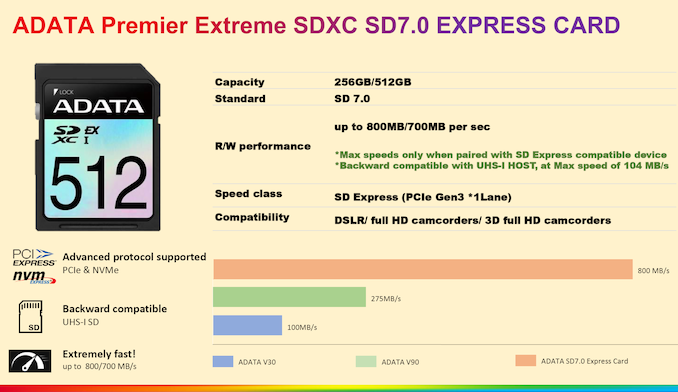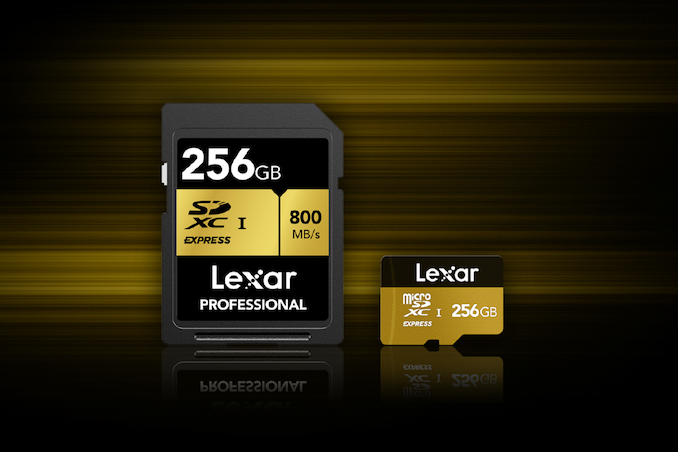Next Gen NVMe SD Card Review: The SM2708 Controller Serves it Hot and Fast
by Ganesh T S on September 9, 2021 9:00 AM EST- Posted in
- Storage
- NAND
- flash
- NVMe
- Silicon Motion
- Memory Cards
- 3D TLC
- SD Express
Miscellaneous Aspects and Concluding Remarks
The appearance of PCIe / NVMe in the memory cards space enables us to bring over some of our direct-attached storage evaluation metrics. Two important aspects are power consumption and thermal characteristics.
Power Consumption
Bus-powered devices can configure themselves to operate within the power delivery constraints of the host port. While Thunderbolt ports are guaranteed to supply up to 15W for client devices, USB 2.0 ports are guaranteed to deliver only 2.5W (500mA @ 5V). In this context, it is interesting to have a fine-grained look at the power consumption profile of the memory card / card reader combination. Using the Plugable USBC-TKEY, the bus power consumption of the drives was tracked while processing the complete test suite. The graphs below plot the instantaneous bus power consumption against time, while singling out the maximum and minimum power consumption numbers.
| Power Consumption Profile [Card + Reader] | |
| TOP: | BOTTOM: |
The Realtek card reader and the SM2708 reference design combination has a peak power consumption of 4.58W, with the average being around 3.25W. On the other hand, in UHS-I mode, the Lexar card reader and the reference design operate at less than 1.67W, with the average being around 1.25W. The extra performance in SD Express mode comes at the cost of power consumption, but that is no surprise.
Thermal Profile
The performance consistency evaluation of the reference design in SD Express mode revealed the internal temperature of the SD card to be around 100C when subject to heavy stress. In order to rule out any errors in the S.M.A.R.T polling, we used a FLIR One Pro thermal imager to capture the thermal profile of the card while being subjected to the performance consistency test.
To our dismay, we found the surface temperature to be as high as 96C - something entirely unsafe for handling with bare hands. It does look like safety standards allow for such surface temperatures, provided the device is under 50mm x 50mm in size. Unfortunately, it is a sad reality that the SD card and microSD card form-factors do not allow for the thermal design necessary to sustain extended operation with NVMe-class speeds. In any case, Silicon Motion's customers can tweak the firmware's configurable parameters to achieve a different balance between performance and temperature. The SM2708 might also held back a bit by its 28nm fabrication node. Once SD Express achieves scale of deployment, it is likely that Silicon Motion can choose more advanced nodes to drive down the power consumption and stress temperatures.
Final Words
Reviewing the Silicon Motion SM2708 reference design has helped us greatly in setting the consumer expectations for SD Express using NVMe right. The advertised numbers can only be achieved in burst mode, and sustained writes may be affected by a combination of SLC cache sizes and thermals. Performance similar to that of a high-end SATA SSD or a PCIe 3.0 x2 NVMe SSD can be expected, though the nature and number of flash pieces inside the card can heavily influence the performance.
Silicon Motion has a couple of design wins ready to ship, with ADATA and Lexar in the final stages of bringing their SD Express products into the market.
Overall, consumers have been waiting for SD Express for quite some time. While CFexpress has taken the early lead with camera / camcorder makers, SD cards have a much wider range of markets to service and target. We are bullish on the prospects for SD Express in verticals such as portable game consoles and SBCs, but it might take a few years for mid-range cameras to start supporting it.
In the meanwhile, products such as the Silicon Motion SM2708 and Realtek RTL9211DS / RTS5261 can prime the market for the new standard on the PC side. A lot is dependent on the vendors not charging too much of a premium for SD Express over the standard UHS-II cards / readers.














43 Comments
View All Comments
shabby - Thursday, September 9, 2021 - link
Lol at the thermals, these things will come with heatsinks one day.bananaforscale - Thursday, September 9, 2021 - link
Unlikely. First there's the form factor (it's not an SD Express card if it's too thick), second there's the packaging. The shell would have to be either open or partially metal.nandnandnand - Thursday, September 9, 2021 - link
Metal SD/microSD cards? It's more likely than you think!NextGen_Gamer - Thursday, September 9, 2021 - link
Metal was my first thought as well. Like the article said, moving the controller to a more advanced process would help, and probably using newer/more advanced NAND memory as well. But even still - I can already see things like the Samsung PRO cards having to use some kind of aluminum casing instead of plastic going forward in order to keep temps in check for sustained use.catavalon21 - Friday, September 10, 2021 - link
Corsair slapped a big ole heat sink on their high speed heaterhttps://www.corsair.com/us/en/Categories/Products/...
shabby - Thursday, September 9, 2021 - link
I know I know that was a joke, perhaps the sdcard holder will have some thick plate on top and once the card is inserted it'll lower down on the card for better heat dissipation 🤷🏼♂️Geef - Sunday, October 10, 2021 - link
If your just joking about a heat spreader just imagine a tiny little fan on top of your SD Card! Super high pitch like a mosquito in your ear buzzing around. :Pschuckles - Friday, September 10, 2021 - link
The thermals are a serious issue, it’s one thing for surface temps of plastic to be near 100C, but if that was metal the surface temps would still hit way too high and metal will actually burn the user.Ultimately these new NVMe sd cards will need better tuning to reduce thermals and improve efficiency.
myaccessflorida - Saturday, September 11, 2021 - link
I think it's more intended for state-of-the-art digital camera that output high bitrate, high resolution video.https://surveyuncle.com/myaccessflorida/
Kangal - Sunday, September 12, 2021 - link
True.But it would be interesting to see these as "cartridges" used for next-gen gaming. Particularly, one where the user can play their game on a Pocketable-console, then eject it, and use it on a Home-console. Maybe it can house "slow assets" like 4K-Textures, whilst the Game Engine is stored in the faster, internal drive.
It's an interesting thought experiment, thinking about a gaming on a Sony PS5 and PSP (or a Sony Phone with removable gamepad, a la JungleCat).